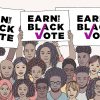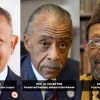
The brutal act of racial terror that took the lives of nine black parishioners at Emanuel African Methodist Episcopal Church in Charleston, S.C., purposely targeted the most important institution that has ever existed in the black community: the black church. So it should come as no surprise that in the age of Ferguson, Mo., Baltimore and #BlackLivesMatter, one of the nation’s most ancient and revered black churches should come under such an attack. Nor that the attack took place in South Carolina, a state so deeply rooted in white supremacy and racial hatred that its Capitol proudly flies the Confederate flag even today.
Black churches, specifically AME and Baptist, gave spiritual, religious and material sustenance to African-American communities during and after slavery. The church drew from African folklore and religions and Christianity to develop a unique blend of a sectarian and secular belief system that allowed black people to survive slavery and its aftermath. The black church’s radical humanism harbored a fierce resistance to slavery, a love of freedom and a thirst for citizenship and equality that made it a hotbed of internal debates, discussions and controversies over the best course for black liberation in America.
Conservatives hewed closely to a politics of respectability, elevating church membership as a badge of honor that might protect African Americans from white hostility. Radicals vowed to secure heaven on earth by any means necessary, including participating in slave rebellions, abolitionist groups and self-help societies. Most steered a middle ground between these poles, sustained by a deep and abiding faith in the black capacity for survival and personal and political transformation.
After slavery, the strength of the black church made it a target of racist vigilantes, with white supremacists turning a religious symbol, the cross, into a burning icon of racial terror. White supremacy’s triumphant return in the South rationalized racial violence and murder as a divine act of “redemption” that would cleanse America from racial impurities by keeping blacks a subject people at all costs.
The African-American church stood in the eye of this white-supremacist storm. Instead of falling apart, the black church practically willed itself to exponential growth through political self-determination, community outreach and organizing that made it, alongside historically black schools, lodges and civic groups, the most important Negro institution America has ever produced. Black churches published newspapers, raised money to build schools and colleges and helped organize libraries, insurance companies and anti-poverty efforts.
Historically black churches, such as Emanuel AME in Charleston, helped to sustain communities against the ravages of Jim Crow, poverty and racial violence that contoured African-American life during this period.
The modern civil rights movement showcased the black church’s central role in the African-American freedom struggle, with black preachers and churchwomen becoming most identified with the movement. Dr. Martin Luther King Jr.’s high visibility during the period helped to obscure the racial violence directed against him, personally, and the church more generally.
During the 1950s and 1960s, hundreds of black churches were victims of racial violence that included gunfire and bombs. The Sept. 15, 1963, bombing at the Sixteenth Street Baptist Church in Birmingham, Ala., is the most famous instance, but far from the only one. The next year, three civil rights workers investigating church bombings in Mississippi disappeared outside of tiny Neshoba County. The missing civil rights workers, Andrew Goodman, Michael Schwerner and James Chaney (two white and one black) were presumed murdered, their bodies found Aug. 4, 1964, in an earthen dam in Mississippi.
At its best, the contemporary African-American church continues in a rich tradition, providing material benefits, community organizing and spiritual renewal for a community that remains scarred by a secular world that remains stubbornly resistant to the idea of black citizenship, let alone black humanity.
Symbolically, the black church has always represented more than a house of worship. Metaphorically, it has represented the protector of black bodies, the educator of black girls and boys and the audacious voice that believes, even now and against all evidence to the contrary, that African-American lives not only matter, but are capable of redeeming the soul of an unrepentantly racist nation.
Peniel E. Joseph, a contributing editor at The Root, is founding director of the Center for the Study of Race and Democracy and a professor of history at Tufts University. He is the author of Waiting ’Til the Midnight Hour: A Narrative History of Black Power in America, Dark Days, Bright Nights: From Black Power to Barack Obama and Stokely: A Life. Follow him on Twitter.














